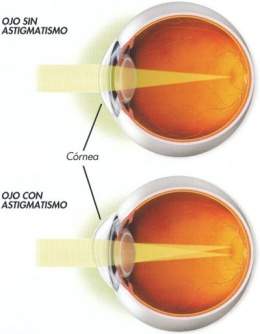It is an eye disorder in which the cornea (covered with transparent tissue in the front of the eye) has an abnormal curve, causing blurred vision. Astigmatism is a very condition, it can occur in conjunction with nearsightedness or farsightedness . A minor degree of astigmatism is considered normal and does not require correction.
It is considered a problem in the curvature of the cornea , which prevents the clear focus of near and far objects. This is because the cornea, instead of being round, flattens at the poles and different radii of curvature appear in each of the main axes. Therefore, when light falls through the cornea, distorted images are obtained.
It occurs because the geometry of the cornea is not the normal spherical, but oblong or toric: it is more like a rugby ball rather than a soccer ball . As a consequence, the light rays are focused on at least two different points on the retina (at the back of the eyeball). This happens for certain directions, that is to say that what characterizes it is that the lenses of the eye do not have the same power in all directions.
In regular astigmatisms, the meridians in which the curvatures are maximum and minimum are located at 180º with respect to each other. These are the easiest to correct.

Causes
Astigmatism is a very common condition. When the distribution of the curvatures of the cornea is more irregular, the correction is more complex. In this case, the origin may be pathological, a consequence of some disease or trauma. This is a hereditary refractive defect and many people who develop it at birth get worse over the years. In other cases it can be caused by:
- keratoconus (gradual narrowing of the cornea into a conical shape).
- pterygium (degeneration of the subepithelial tissue of the conjunctiva).
- a scar on the cornea due to, for example, some types of surgery.
Symptoms
When the eye is slightly astigmatic, vision is just a little blurry. If astigmatism is more pronounced, it can lead to headaches, eye strain, and distorted or blurred vision at all distances. It manifests itself particularly when patterns formed by lines or grids are observed: since it is a “directional” problem (it manifests itself for certain orientations), horizontal lines are not seen with the same sharpness as vertical or oblique lines.
In fact, an astigmatic eye looking at the image of a point will instead see a small segment more or less blurred in one direction (the direction in which the cornea is flattened). When you observe a series of lines oriented in different directions, there will be some that are perceived as especially blurry and those that are perpendicular to this will be the sharpest. The optotypes designed to detect this optical condition are based on this fact.
It can affect both adults and children. When it comes to children it is more difficult to detect because they probably will not complain that they see blurry or distorted. It is important to detect it as soon as possible since it can affect their academic performance or their performance when playing or practicing sports , so it is convenient to take them for review from time to time.
The most frequent symptomatology of astigmatism is the perception of distorted images. However, it can often cause headaches or eye discomfort. In addition, depending on the age, the amount and the type of astigmatism, the symptoms may be different, and may not even affect vision.
Types
There are several types of astigmatism:
- Simple Astigmatism: Appears on only one axis.
- Compound astigmatism: in addition to affecting one axis, it is associated with myopia or hyperopia.
- Mixed astigmatism: when one axis is focused in front of the retina (myopic) and another behind the retina (hyperopic).
Treatment
Like other eye defects, astigmatism can be compensated by glasses (lenses) and contact lenses except in very extreme cases. A few years ago, the only valid contact lenses to correct it were rigid (RGP), currently soft lenses are also used: they are toric lenses. However, in severe cases, RGP or glasses are prescribed.
It is possible that in extreme cases, the newly compensated patient may suffer vertigo for a few days until the brain gets used to the new “” way of seeing “”. You will think that the objects are deformed although you will see them more clearly the first few weeks after the day you start wearing the glasses or lenses.
Depending on the severity and type of defect, it is possible to correct it by refractive surgery
